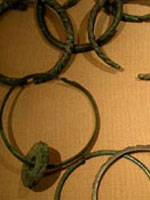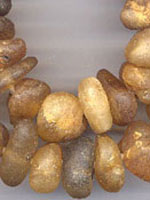A single spark ignites a bonfire. The crude beginning of beading and jewelry making evolved into a wildfire of creativity and jewelry design. Bead stringing began with egg and stone. It escalated into an art with shaped glass beads and standardized beads that allowed for uniform designs. The Stone Age ended with a simple foundation. The Bronze Age erupted with exploration and built upon that foundation. Bead stringing artisans advanced the craft a thousandfold.
The Bronze Age saw many advances in the art of jewelry design. The process of drilling channels in beads evolved to the point that it was much easier to create a bead out of any stone, regardless of shape and size. Bead drilling was refined so that it no longer shattered and broke the stone. Trade exploded and merchants began seeking rare beads and stones that were not familiar to the local populace. The market for beading was born and the craft was now thriving.

14th century B.C. The ship sailed away from Cyprus where three hundred-fifty copper ingots had been loaded. At Uluburun, heavy winds pushed the ship to shore. Rocks tore into the cedar skin of the ship, crippling it. It sank towards the bottom, smashing down on a steep, rocky slope. The stern settled forty-four meters down, while the bow nosed into depths of fifty-two meters. The cargo scattered.
1982, Mehmet Cakir, a Turkish sponge diver went diving off the south coast of Turkey. During his dive, he spotted metal objects on the floor of the Mediterranean Sea. The Institute of Nautical Archaeology had taught Mehmet to be observant of anything that could indicate a wreck was nearby. He reported his findings. George Bass, the project director of the INA began diving the wreck two years later.

The shipwreck at Uluburun is the oldest in the world. The ship hailed from the late Bronze Age, loaded with 'royal cargo'. Carried aboard was copper and tin ingots, glass, amber, ebony, ostrich eggs, ivory, finished jewelry, tableware and weapons. The excavation of the ship lasted ten years and yielded more than 18,000 artifacts.
Amongst the cargo was a large assortment of jewelry and beads. The jewelry included gold pendants and medallions, silver bangles and sea shell rings. The bead findings are an incredible mix: agate, quartz, amber, steatite, chalcedony, faience, shell, and glass. The beads ranged in size and shape, from seed beads to large focal pieces.
Another Bronze Age site was excavated in 2005. The Orkney Islands hosted a dig on an ancient cemetery. The Orkney Islands are a network of seventy islands off the northern end of Scotland, fifty miles south of Greenland. The cemetery, named The Knowes o' Trotty, is made up of barrows - large mounds of stones and earth buried over the dead. Initially, the Knowes may have been comprised of twenty barrows, time, weather, and the local fauna have eroded many of the large mounds and now only sixteen remain. The remaining barrows are set in two rows, perhaps symbolically representing a gateway to the next world.

This was not the first time the Knowes o' Trotty has been excavated. In 1858, a local Sheriff Clerk and antiquarian named George Petrie dug the largest of the mounds. Amongst charred human bones, he unearthed twenty-seven amber beads and four gold "sun" discs. The largest of the discs was 76mm and had a hole in the center. Petrie would later write, "It is probable that a number of beads have been lost among the debris which got into the grave."
The most recent excavation of the Knowes o' Trotty has given up gold fragments, rectangular saucer plates, and triangular amber beads. The beads have a similar style and design as amber that was found in Wessex, England. It is thought that the amber arrived in this region as a necklace. The amber also looks much older than the site; the piece may have been an heirloom.
The Isle of Thanet in Kent has revealed many Bronze Age artifacts. Some of the earliest metalwork and adornments known in Britain has been found there. Bronze bracelets have been discovered. A necklace of over two hundred jet beads was unearthed. All of the items were unearthed under barrows.
Bronze Age beads were a leap of innovation from their earlier Stone Age cousins. Beads were now and assortment of sizes. They were now complex shapes. Gone was the smoothing and boring. The beads were now drilled, etched, and shaped. Glass bead making was in its infancy. Double drilling was a big forward movement of stone beads. A single, drilled hole in a stone bead could shatter it. A single drill could blast out the opposite end with a gaping hole, rather than a small channel. Double drilling allowed two holes to meet in the center of the bead, a much gentler process on the stone.

The expanding crawl of trade routes helped beading and craft working develop as well. The beaders of the time cherished and appreciated harder materials to acquire. This pushed the traders to seek out more rare and exotic materials. Trade routes also gave the beaders of the Bronze Age standardized beads - the beads were small and portable. Raw materials also made their way across the routes, allowing craftsmen to fashion goods into beads.
The Iron Age would usher further evolutions in the artistry of beading. Glass beads would go beyond cruder faience beads. Glass bead makers would duplicate some stones, like agate, so precisely that it was nearly impossible to differentiate the stone from the man-made bead. Glass would see advances with the march of Rome throughout the land. "Roman-Period" glass would be so valuable on the trade circuit that it would be found throughout the world in such varied places as Ethiopia, Iran, China, and Korea - this stemming from production factories in Italy, Switzerland, France, and Germany.
Visit the Soft Flex Company YouTube Channel!
Blog contributor Thomas Soles is the Trade Show Coordinator for Soft Flex Company. His favorite stones are Lapis and Pietersite. His favorite hobby is day dreaming. And his favorite mustache is Tom Selleck's. As you can see, he has a healthy (or possibly unhealthy) sense of humor. You can write to him at Thomas@SoftFlexCompany.com




